Helge Rhodin
Follow My Hold: Hand-Object Interaction Reconstruction through Geometric Guidance
Aug 25, 2025Abstract:We propose a novel diffusion-based framework for reconstructing 3D geometry of hand-held objects from monocular RGB images by leveraging hand-object interaction as geometric guidance. Our method conditions a latent diffusion model on an inpainted object appearance and uses inference-time guidance to optimize the object reconstruction, while simultaneously ensuring plausible hand-object interactions. Unlike prior methods that rely on extensive post-processing or produce low-quality reconstructions, our approach directly generates high-quality object geometry during the diffusion process by introducing guidance with an optimization-in-the-loop design. Specifically, we guide the diffusion model by applying supervision to the velocity field while simultaneously optimizing the transformations of both the hand and the object being reconstructed. This optimization is driven by multi-modal geometric cues, including normal and depth alignment, silhouette consistency, and 2D keypoint reprojection. We further incorporate signed distance field supervision and enforce contact and non-intersection constraints to ensure physical plausibility of hand-object interaction. Our method yields accurate, robust and coherent reconstructions under occlusion while generalizing well to in-the-wild scenarios.
Digital Twin Generation from Visual Data: A Survey
Apr 17, 2025Abstract:This survey explores recent developments in generating digital twins from videos. Such digital twins can be used for robotics application, media content creation, or design and construction works. We analyze various approaches, including 3D Gaussian Splatting, generative in-painting, semantic segmentation, and foundation models highlighting their advantages and limitations. Additionally, we discuss challenges such as occlusions, lighting variations, and scalability, as well as potential future research directions. This survey aims to provide a comprehensive overview of state-of-the-art methodologies and their implications for real-world applications. Awesome list: https://github.com/ndrwmlnk/awesome-digital-twins
DreamTexture: Shape from Virtual Texture with Analysis by Augmentation
Mar 20, 2025Abstract:DreamFusion established a new paradigm for unsupervised 3D reconstruction from virtual views by combining advances in generative models and differentiable rendering. However, the underlying multi-view rendering, along with supervision from large-scale generative models, is computationally expensive and under-constrained. We propose DreamTexture, a novel Shape-from-Virtual-Texture approach that leverages monocular depth cues to reconstruct 3D objects. Our method textures an input image by aligning a virtual texture with the real depth cues in the input, exploiting the inherent understanding of monocular geometry encoded in modern diffusion models. We then reconstruct depth from the virtual texture deformation with a new conformal map optimization, which alleviates memory-intensive volumetric representations. Our experiments reveal that generative models possess an understanding of monocular shape cues, which can be extracted by augmenting and aligning texture cues -- a novel monocular reconstruction paradigm that we call Analysis by Augmentation.
Object and Contact Point Tracking in Demonstrations Using 3D Gaussian Splatting
Nov 05, 2024Abstract:This paper introduces a method to enhance Interactive Imitation Learning (IIL) by extracting touch interaction points and tracking object movement from video demonstrations. The approach extends current IIL systems by providing robots with detailed knowledge of both where and how to interact with objects, particularly complex articulated ones like doors and drawers. By leveraging cutting-edge techniques such as 3D Gaussian Splatting and FoundationPose for tracking, this method allows robots to better understand and manipulate objects in dynamic environments. The research lays the foundation for more effective task learning and execution in autonomous robotic systems.
Representing Animatable Avatar via Factorized Neural Fields
Jun 02, 2024Abstract:For reconstructing high-fidelity human 3D models from monocular videos, it is crucial to maintain consistent large-scale body shapes along with finely matched subtle wrinkles. This paper explores the observation that the per-frame rendering results can be factorized into a pose-independent component and a corresponding pose-dependent equivalent to facilitate frame consistency. Pose adaptive textures can be further improved by restricting frequency bands of these two components. In detail, pose-independent outputs are expected to be low-frequency, while highfrequency information is linked to pose-dependent factors. We achieve a coherent preservation of both coarse body contours across the entire input video and finegrained texture features that are time variant with a dual-branch network with distinct frequency components. The first branch takes coordinates in canonical space as input, while the second branch additionally considers features outputted by the first branch and pose information of each frame. Our network integrates the information predicted by both branches and utilizes volume rendering to generate photo-realistic 3D human images. Through experiments, we demonstrate that our network surpasses the neural radiance fields (NeRF) based state-of-the-art methods in preserving high-frequency details and ensuring consistent body contours.
CasCalib: Cascaded Calibration for Motion Capture from Sparse Unsynchronized Cameras
May 10, 2024



Abstract:It is now possible to estimate 3D human pose from monocular images with off-the-shelf 3D pose estimators. However, many practical applications require fine-grained absolute pose information for which multi-view cues and camera calibration are necessary. Such multi-view recordings are laborious because they require manual calibration, and are expensive when using dedicated hardware. Our goal is full automation, which includes temporal synchronization, as well as intrinsic and extrinsic camera calibration. This is done by using persons in the scene as the calibration objects. Existing methods either address only synchronization or calibration, assume one of the former as input, or have significant limitations. A common limitation is that they only consider single persons, which eases correspondence finding. We attain this generality by partitioning the high-dimensional time and calibration space into a cascade of subspaces and introduce tailored algorithms to optimize each efficiently and robustly. The outcome is an easy-to-use, flexible, and robust motion capture toolbox that we release to enable scientific applications, which we demonstrate on diverse multi-view benchmarks. Project website: https://github.com/jamestang1998/CasCalib.
Gaussian Shadow Casting for Neural Characters
Jan 11, 2024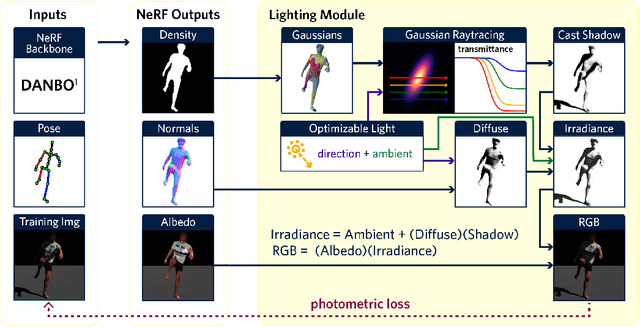

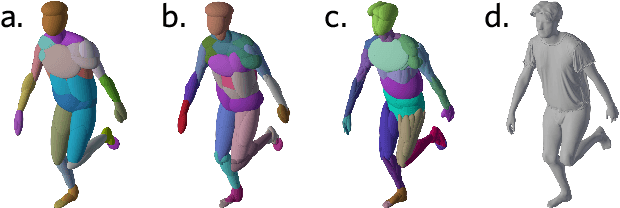

Abstract:Neural character models can now reconstruct detailed geometry and texture from video, but they lack explicit shadows and shading, leading to artifacts when generating novel views and poses or during relighting. It is particularly difficult to include shadows as they are a global effect and the required casting of secondary rays is costly. We propose a new shadow model using a Gaussian density proxy that replaces sampling with a simple analytic formula. It supports dynamic motion and is tailored for shadow computation, thereby avoiding the affine projection approximation and sorting required by the closely related Gaussian splatting. Combined with a deferred neural rendering model, our Gaussian shadows enable Lambertian shading and shadow casting with minimal overhead. We demonstrate improved reconstructions, with better separation of albedo, shading, and shadows in challenging outdoor scenes with direct sun light and hard shadows. Our method is able to optimize the light direction without any input from the user. As a result, novel poses have fewer shadow artifacts and relighting in novel scenes is more realistic compared to the state-of-the-art methods, providing new ways to pose neural characters in novel environments, increasing their applicability.
A Data Perspective on Enhanced Identity Preservation for Diffusion Personalization
Nov 07, 2023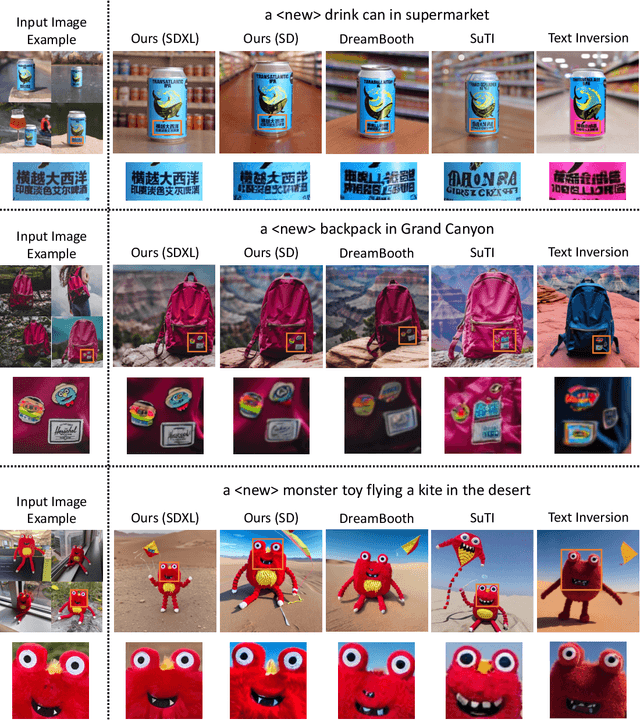

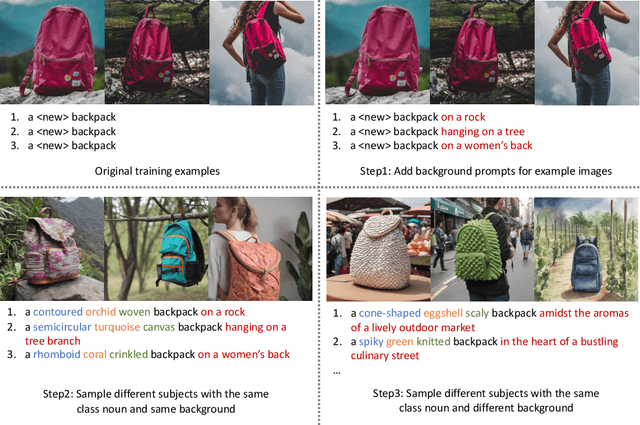
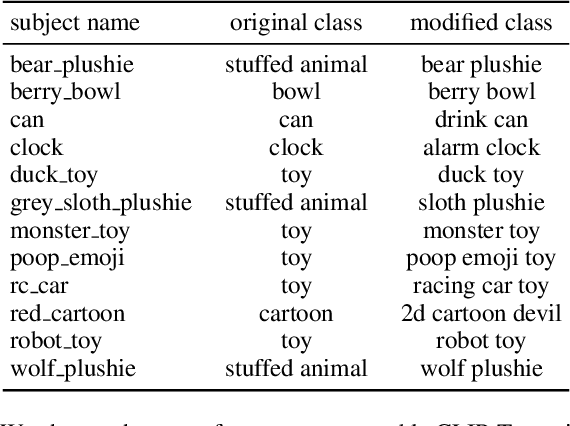
Abstract:Large text-to-image models have revolutionized the ability to generate imagery using natural language. However, particularly unique or personal visual concepts, such as your pet, an object in your house, etc., will not be captured by the original model. This has led to interest in how to inject new visual concepts, bound to a new text token, using as few as 4-6 examples. Despite significant progress, this task remains a formidable challenge, particularly in preserving the subject's identity. While most researchers attempt to to address this issue by modifying model architectures, our approach takes a data-centric perspective, advocating the modification of data rather than the model itself. We introduce a novel regularization dataset generation strategy on both the text and image level; demonstrating the importance of a rich and structured regularization dataset (automatically generated) to prevent losing text coherence and better identity preservation. The better quality is enabled by allowing up to 5x more fine-tuning iterations without overfitting and degeneration. The generated renditions of the desired subject preserve even fine details such as text and logos; all while maintaining the ability to generate diverse samples that follow the input text prompt. Since our method focuses on data augmentation, rather than adjusting the model architecture, it is complementary and can be combined with prior work. We show on established benchmarks that our data-centric approach forms the new state of the art in terms of image quality, with the best trade-off between identity preservation, diversity, and text alignment.
Mirror-Aware Neural Humans
Sep 09, 2023Abstract:Human motion capture either requires multi-camera systems or is unreliable using single-view input due to depth ambiguities. Meanwhile, mirrors are readily available in urban environments and form an affordable alternative by recording two views with only a single camera. However, the mirror setting poses the additional challenge of handling occlusions of real and mirror image. Going beyond existing mirror approaches for 3D human pose estimation, we utilize mirrors for learning a complete body model, including shape and dense appearance. Our main contributions are extending articulated neural radiance fields to include a notion of a mirror, making it sample-efficient over potential occlusion regions. Together, our contributions realize a consumer-level 3D motion capture system that starts from off-the-shelf 2D poses by automatically calibrating the camera, estimating mirror orientation, and subsequently lifting 2D keypoint detections to 3D skeleton pose that is used to condition the mirror-aware NeRF. We empirically demonstrate the benefit of learning a body model and accounting for occlusion in challenging mirror scenes.
Pose Modulated Avatars from Video
Aug 25, 2023Abstract:It is now possible to reconstruct dynamic human motion and shape from a sparse set of cameras using Neural Radiance Fields (NeRF) driven by an underlying skeleton. However, a challenge remains to model the deformation of cloth and skin in relation to skeleton pose. Unlike existing avatar models that are learned implicitly or rely on a proxy surface, our approach is motivated by the observation that different poses necessitate unique frequency assignments. Neglecting this distinction yields noisy artifacts in smooth areas or blurs fine-grained texture and shape details in sharp regions. We develop a two-branch neural network that is adaptive and explicit in the frequency domain. The first branch is a graph neural network that models correlations among body parts locally, taking skeleton pose as input. The second branch combines these correlation features to a set of global frequencies and then modulates the feature encoding. Our experiments demonstrate that our network outperforms state-of-the-art methods in terms of preserving details and generalization capabilities.
 Add to Chrome
Add to Chrome Add to Firefox
Add to Firefox Add to Edge
Add to Edge